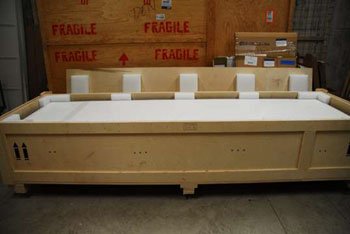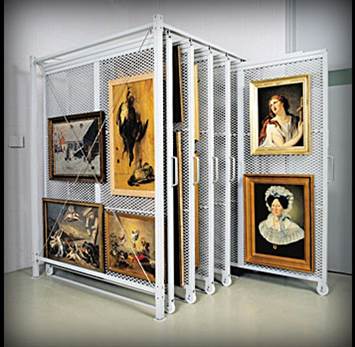Museum Materials Sample Booklet
Ordering archival supplies can be difficult and confusing. This booklet provides sample materials of the most common supplies currently offered and discusses how they are used in museums. Organized by function, the booklet covers rigid materials, padding materials, ties and attachments, barrier materials and "bad" materials.
|
Museum Materials Sample Booklet
| $45.00 |
|
Congratulations to Gawain Weaver

We would like to congratulate museumclasses.org instructor Gawain Weaver who recently was awarded a 2012 WISE award for Excellence in Online Education. |
Polyethylene Foam By Helen Alten
Polyethylene foams are the back-bone of museum storage and exhibit mounts. They are used to line drawers, make mannequins, and pack objects for transport. However, most plastics have not been around long - less than a century. We are still learning how they age and change with time. Not all polyethylene foams are created equally. There is a nice article by R. Scott Williams of the Canadian Conservation Institute that compares foams in the AIC Newsletter, January 2002 ( Polyolefin Foams, 27/1, 26-30, 31-34). The conclusion in that article is that the closed cell foams - plastazote, volara and nalgene - probably have better aging properties than their open cell counterparts, of which Ethafoam is the most popular. Recently I was examining an object mounted on Plastazote. The mount was less than a year old. I saw a change in the surface gloss of the wood artifact. Under UV light there was a slightly noticeable change - but only with one of the three UV light sources I used to examine the object. The wood was polished, but did not seem to have a coating. It might have had an oil coating, although, again, UV showed nothing. Plastazote is much softer than Ethafoam, so scratching didn't seem likely as the cause of the surface change. In a different museum, polyethylene shelf liner showed distinct efflorescent patterns under UV light exactly where hide and skin objects had sat on them for awhile in storage. A colleague mentioned that polyethylene bags become stiff when they store hide and skin samples for awhile. Is there a reaction between the skin proteins and the polymer? Williams points out in his 2002 article that "Polyamide slip agents are on the surface of most polyolefin sheets, and these have not been reported to cause problems, other than tarnishing of mirror polished metal surfaces." More research needs to be done on these popular storage materials. Although we treat them as if they are consistently the same, Williams points out that there is large variety depending on manufacturer, product, brand and date of manufacture. He asks that we keep track of this information when we purchase foam or plastic products, and then report to him any problems we note. For example, I saw a large batch of polyethylene foam yellow and lose its ability to spring back after pressure. However, by the time this was noted on storage mounts, the history of the source of the foam was long gone. Recently while being shown new storage upgrades at a colleague's museum, there was an overwhelming chemical smell when a drawer was pulled open. The foam was producing gases, which hadn't been noticed until it was enclosed in a small space for awhile. Polyethylene foams are still the best material we have for their purpose. But, perhaps, using an unbuffered acid-free tissue paper or a well-washed cotton fabric separator between the object and the foam should become common practice. Helen Alten is the Director of Northern States Conservation Center and its Chief Objects Conservator.
|
Regional Workshops
Where you can find some of our instructors this year:
Gawain Weaver
The Care and Identification of PhotographsAdvanced Photograph Conservation Workshops
- October 21-24, 2013 (Huntington Library, San Marino, CA)
Steve Layne
- August 3-7, 2013, San Diego, CA
Management of Aggressive Behavior (MOAB) Half-Day Class
- October 9, 2013, Salt Lake City, UT
Protecting Property, People & Collections in an Ever-Changing World
- October 9, 2013, Salt Lake City, UT
Brad Bredehoft
Northern States will again be an exhibitor at the AASLH Annual Meeting. Look for us across from the Awards Showcase.
- September 19-20, Birmingham, Alabama
|
|
|
Welcome to the Collections Caretaker e-Newsletter from Northern States Conservation Center. The newsletter is designed to bring you timely and helpful content that is pertinent to situations we all encounter in our museum and archives work. Feel free to let us know what topics you would like to see featured in Collections Caretaker or even contribute an article.
|
|
|
Paintings Packing and Transport
By Victoria Montana Ryan
 | Packing Crate for Paintings
|
Once I was an expert witness in a trial about damage to a painting moved across the country. A client engaged a moving company based on the understanding that the company had the expertise to properly pack a painting. The moving company built a shallow cage of wooden slats and laid cardboard directly on the painting surface. The painting was not well protected and damage occurred - some caused by the packing materials. Although there are widely recognized standards for proper painting packing - the movers had obviously not read them.
Before transporting and deciding on the appropriate packing method for a painting, consider the destination, environmental changes, number of venues and mode of transport. A detailed condition report of the painting prior to packing should help you determine potential problems. Try to mitigate the risk by choosing protective packing materials and techniques.
Common hazards
Transport always involves some degree of vibration. Vibration presents few problems for most stable paintings, but can damage unstable works. Other physical forces, such as impact from being dropped, present another hazard. Thermal shock may occur from environmental changes, despite materials used in packing to reduce such risks. A painting left on a hot or rainy airport tarmac for hours can be subjected to such environmental changes despite best efforts to ensure safe passage. If transport is by truck, the truck should be equipped with air-ride suspension to minimize vibrations and temperature control to minimize thermal shock.
Transit
Before transit, wrap the painting in polyethylene, whether it will be traveling in a crate or not. (See Wrapping a Painting, CCI Notes 10/16)
For short distance moves, paintings may be soft-packed using padding materials and cardboard sleeves or boxes. However, this may not provide enough support, depending on the location, environment, or other relevant conditions. In these instances, it is better to have a 'travel crate.' Though travel crates look somewhat like cages, they provide a bit more support and protection. Support is enhanced by placing the painting in a soft-pack box inside the travel crate.
Special crates are often constructed to transport paintings any distance. White pine is better than plywood for wood crates. When unpacking crates, carefully observe how the packing was done. Often paintings are double packed - that is packed inside a box inside a box (or crate). Artworks often "float" packed in a box or crate with corners supporting the painting in place. These corners are usually made of polyurethane ester foam. The Canadian Conservation Institute has an excellent article on the specifics of such corners for packing, Corner Pads for Double Case Packages. Some materials provide better insulation and shock absorption than others. Polyurethane foam is an excellent insulator, better than polyethylene foam. However, polyurethane foam is not an inert material and should not be used for long-term storage.
Make labels and other markings on cases easy to read. Use arrows to show the correct orientation for the crate. Include packing instructions inside the crate. Condition reports and photos should also accompany the packed painting.
If you need to pack and transport a painting, consult the Art in Transit Handbook. It is an excellent resource for a thorough discussion of proper art packing. Chapters include:
Assessing Risks, Transit Climate Conditions, Temperature Protection, Relative Humidity Protection, Shock and Vibration Hazards, Shock Protection, Vibration Protection, Packing Cases and the Role of the Courier.
Security and Insurance
Besides methods, materials and transport mode, consider security during transit, including time of transfer between transports and on loading docks. Insurance, based on the painting's appraised value, is another necessity. Most insurance coverage requires proper packing to be in effect.
(Excerpt from the course MS227 Care of Paintings.)
Victoria Montana Ryan is a former Assistant Professor for the Conservation of Paintings at Queen's University Kingston, Ontario and former adjunct faculty member at the University of Denver where she was conservator of paintings at the Rocky Mountain Conservation Center for over a decade. She received her Master of Art Conservation from Queen's University and a Master of Arts degree with an emphasis in Art Education/Museum Studies from the University of New Mexico. Ms. Ryan has authored papers on the care of paintings, integrated pest management, and the importance of working with appraisers. She has appeared on the Discovery Channel to discuss care of personal treasures. A Fellow of the American Institute for Conservation, Ms. Ryan is also a member of the Western Association for Art Conservation and the Canadian Association for Conservation. She resides in Colorado Springs, CO where she operates her private conservation practice, Art Care Services, to serve the conservation needs of museums, historical societies, public and private collectors, institutions, corporations, and municipalities, focusing on the care and preservation of works of art. For more information visit her web site Art Care Services.
|
Constructing the Ideal Storage Space
By Helen Alten & Lori Benson The best storage space follows principles of good design. It should be cost effective to build and cost effective to use and maintain. It should protect the collection. Climate controls have the single largest impact on collection longevity. Climate control is among the first sacrifices by penny-pinching architects.  | | Vertical Screens |
Well-designed storage should be easy to monitor and clean. My father, an architect, suggested that the most efficient room was round -- cleaning was quick because it had no corners. How will staff keep floors clean? This includes the area under storage shelves and cabinets. Compactor units may allow easy cleaning of the entire floor. So, too, may rolling cabinets or cabinets raised high enough to allow cleaning underneath. One museum developed an innovative room for storing wet collections. It incorporated a grillwork floor so broken jars and alcohol could flow out of the space. However, shoes stick in the holes, carts vibrate excessively, the grill cannot be lifted for easy cleaning (after a couple years the floor under the grill is disgusting), and many of the collection items, even in containers, are small enough to fall through. What seemed a smart, innovative, storage solution has turned into a maintenance nightmare. Storage Design Team When designing storage, the team should include museum professionals and non-museum professionals. From the museum staff include a curator, conservator, collection manager and the heads of security, facilities and maintenance. If you don't have that many staff, consider assigning volunteers to research the concerns of each of those areas. Non-museum professional on the storage design team include the architect, mechanical and structural engineers, security consultants and fire suppression consultants.
Blueprints
Examine blueprints carefully. Pay attention to the placement of windows, doors, ventilation ducts, sprinklers and plumbing. Notice what spaces are next to each other. Does a staff break room or a bathroom share a wall with a storage area? This would increase pest, water and fire risks in storage. Where are public spaces, and where are private spaces? Where are fire escape corridors? Question everything on the floor plan and the elevations. What is the useable ceiling height once the ducts, sprinklers, lights and emergency signs are installed? Insist on meetings throughout the design and build phase of the project. As-builts (the building plan that reflects all the changes since the original designs) are often different from the original blueprints. Often the electrician, plumber or pipe fitter installing the equipment will approximate its location rather than sticking to the drawings. This can result in wasted wall space and/or low ceilings. Some museums write pre-construction manuals and require the architect to follow it. This should list all non-negotiable building components that must be provided. When construction begins, architects usually encounter cost overruns and want to cut expensive environmental control and filtering systems. Staff can bring out the pre-construction agreement and point out that the architect promised specific environmental controls. Architects often do not want to cut less important items such as expensive finishes--doing so alters their creative vision.
Storage Area RequirementsStorage areas do not need to be pretty. But they do need to be neat and clean. Walls should be painted and floors sealed. Most modern storage areas have concrete floors and cinderblock walls. Depending on the value of your collection, you should build so that it is nearly impossible to cut through storage walls and doors. Although concrete contributes moisture and alkaline salts to the atmosphere for a number of years, wood will emit volatile organic chemicals (VOCs) for far longer. Also, concrete is more flame resistant than organic materials. Carpets are not recommended. They can hide pest infestations and provide habitat and food. Carpets also emit volatile chemicals. The
floor, walls and ceiling should have vapor barriers and insulation-especially if storage areas have separate climate controls. Wide doors, access corridors and interior room corridors make moving big artifacts and storage cabinets much easier. Keep ceilings open. Drop ceilings provide pest habitat and disguise leaks. Although pipes and ductwork should not be in storage, if present, they should be clearly labeled. Duct linings should be external, not internal. Make sure duct openings are sealed where they pass through walls, floors and ceilings. Internally, ducts may need a fire damper to preserve the fire retardant properties of the storage room walls.
Use white acrylic emulsion latex paint on the interior walls and ceiling. To improve the fire retardant properties of non-masonry walls, use intumescent fire-retardant paint on the non-collection room side of the wall. Intumescent paint foams up when heated to form a fire barrier. Also, construct the wall using metal studs rather than wood. Avoid oil-based paints and polyurethane, single-component epoxies and alkyd paints. Coat cured concrete floors with solvent-borne epoxy sealer, topped with a moisture-cure epoxy sealer. (Excerpt from the course MS 202: Museum Storage Facilities & Furniture, developed by Helen Alten and revised and taught by Lori Benson.) Lori Benson, is an independent museum professional based in Maine. After a series of project positions at the Minnesota Historical Society, including Assistant Moving Coordinator, she was hired by the Science Museum of Minnesota as their first Collections Manager in 1994. She was Project Director in the Research and Collections Division for the new facility planning and move. The project was published as Moving the Mountain, the Science Museum of Minnesota Guide to Moving Collections. For years, she has taught museum studies to undergraduates and given many talks and lectures on preservation, deaccessioning, project planning and moving. She is a member of the Society for the Preservation of Natural History Collections and the Registrars' Committee of the American Association of Museums. Ms. Benson teaches MS201: Storage for Infinity, MS202: Museum Storage Facilities & Furniture, and MS262: Moving Collections. |
Turning Points; Ordinary People, Extraordinary Change
The 2013 American Association for State and Local History (AASLH) Annual Meeting in Birmingham, Alabama September 18 - 21 will focus on "Turning Points; Ordinary People, Extraordinary Change." Why should you attend? There are more than 70 sessions on the latest in developing, delivering, and connecting to history. Find colleagues who share your specific and unique challenges by participating in an AASLH Affinity group event. Learn how individual people can change lives, institutions and history. Explore the exhibit hall. Look for Northern States Conservation Center's booth across from the awards showcase. If you are unable to attend, try AASLH's online conference. Sign up to hear six live broadcasts of annual meeting sessions. You can participate, ask questions, and make comments from your desk or kitchen table! View the schedule and register for the online conference at www.aaslh.org/am2013.
|
Northern States Conservation Center (NSCC) provides training, collection care, preservation and conservation treatment services. NSCC offers online museum studies classes at www.museumclasses.org in Collections Management & Care, Museum Administration & Management, Exhibit Practices and Museum Facilities Management.
Sincerely,
Helen Alten, DirectorBrad Bredehoft, Sales and Technology Manager Peggy Schaller, Publications Manager
|
|
|
|
|
|
|



